
Home Page
About Us
Deer
Wild Pigs
Bear
Antelope
Elk
Big Horn Sheep
Wild Turkey
Pheasant
Quial
Chukar
Dove
Pigeon
Ducks
Geese
DFG Offices
Licenses/Tag Fees
Hunter Education
National Forests
BLM Offices
Guides/Outfitters
Clubs/Organizations
 Wildlife
Wildlife
Management

Contact Us

|
Wildlife Management
American Sportsmen and Women Contribute to Wildlife
Conservation |
For generations, American sportsmen and women have taken the lead in
preserving, protecting and managing a vital part of our country's heritage: our wild
animal populations. We all owe a debt of gratitude to wildlife conservation groups.
We tip our hat to the sportsmen and women who have made these organizations successful
through their tireless enthusiasm, financial donations and volunteered time.
It's hard to believe that at the turn of the century whited-tailed deer, wild turkeys,
antelope, elk and a host of other species were nearly gone from the face of America. Loss
of habitat, market slaughter and unregulated hunting were all factors in what seemed like
the inevitable doom of wildlife. But the true conservationists stepped forward and
demanded action. Even though the country was in the depth of the Great Depression,
hunters and anglers worked with Congress to establish the Wildlife Restoration Program
with money received from taxes on the sale of sporting guns and ammunition to be used for
wildlife management and restoration. Later, the program was expanded to include more
products as well as fishing equipment and fish and wildlife rebounded.
As hard as it is to believe, in 1900 less than 500,000 white-tailed deer remained in the
U.S. Today, conservation efforts have returned whitetail populations to more than 18
million deer. Less than 100,000 wild turkeys remained in the wild in the early 1900s.
Today, the gobbles and clucks of nearly five million birds can be heard across the country,
from the southern cypress swamps to stands of ponderosa pines in the western states.
Hunters and anglers in this country have contributed more than $17 billion towards wildlife
conservation through fish and wildlife restoration programs. And that doesn't include the
$300 million generated annually by conservation organizations such as the Rocky Mountain
Elk Foundation and Ducks Unlimited.
So-called "animal rights" groups cannot claim any wildlife successes. Their monies are
used for propaganda, litigation and advancing their anti-hunting and anti-fishing agendas.
These actions do nothing for wildlife restoration or conservation.
America's sportsmen and women do this work quietly, without creating headlines or holding
rallies. They plant habitat and food plots that guarantee wildlife will have cover to
protect them from predators and food to get them through winter. They adopt National
Wildlife Refuges, using their time and money to enhance the work done by state and
federal wildlife managers. They teach hunting and fishing education to people of all
ages and abilities.
The eerie call of the loon, the familiar honk of a Canada goose, the hair-raising shrill
of a bugling bull elk, we truly owe them all to America's hunters and anglers. |
| |
| Cabela's 1999 Wildlife Conservation Calendar |
|
